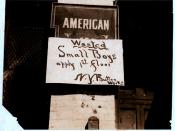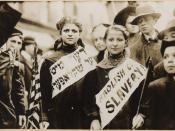Working conditions
Working today is usually quite safe. The government has made laws forcing employers to look after the workforce and provide safety equipment and other things. At the start of the Industrial Revolution none of these laws existed and so working in a factory could prove to be very dangerous.
Industries such as the cotton trade were particularly hard for workers to endure long hours of labor. Steam engines intensified the heat inside these factories. Machinery was not safe to work around; these workers would be constantly risking their lives while working. Because children were small, they were often hired to go into these machines and make repairs. This was a high risk to their safety and as a result, there were many machinery related deaths among the working class of children. The number of hours that workers had to work was also an exhausting amount. 12 hour workdays in the hot, dangerous factories were not uncommon.
Exhaustion eventually leads to the workers slow, unresponsive which is a concern within its self.
Not all factories were this horrible. A group of people called reformer tried to help improve conditions in the workplace. These people wanted changes to the way that factories were run. They faced opposition from other mill owners who knew that reforms would cost them money and give the workers more rights. (They wanted to make as much profit as possible. The reformers gradually managed to force changes to the way that workers were treated. Some of these reforms are listed below.
Factory Act 1819Limited the hours worked by children to a maximum of 12 per day.
Factory Act 1833Children under 9 banned from working in the textiles industry and 10-13 year olds limited to a 48 hour week.
Factory Act 1844Maximum of 12 hours work per...


